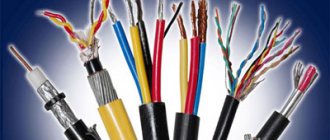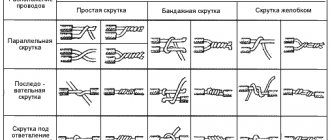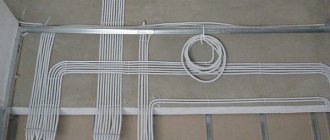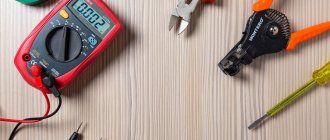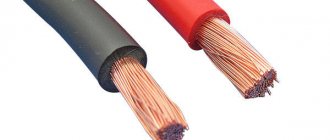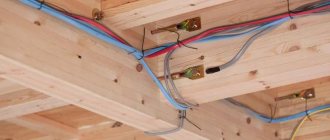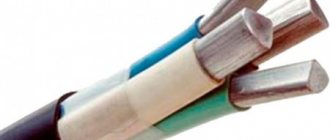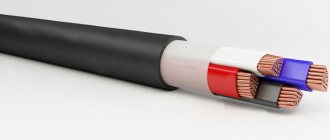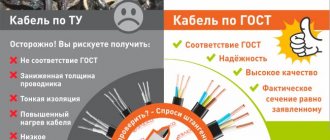All cable products can be divided into two parts - soft and hard wires and cables. Their mobility is classified more deeply - by flexibility class. Which one to choose and which is better: single-core or stranded wire is often asked by novice electricians. At the same time, what is actually meant is not the number of cores, but their structure. Therefore, it is more correct to say multi-wire or single-wire. In this article we will tell you the difference between the compared conductors and where each design option is used.
Features of single-core wires
A single-wire cable has little flexibility.
After installation, it should not be subjected to mechanical stress. It is not recommended to move or bend it. This can lead to the core breaking off, as a result of which the power supply to connected consumers will cease. To restore it, it may be necessary to replace the entire emergency wiring line. Given this feature, it is recommended to use it for a fixed connection. The best option would be to lay a single-core wire in the wall groove. With this installation option, movement of the conductor is eliminated. On the other hand, a single-core cable can better withstand tensile and compressive loads. Comparing the conductivity of single-core and stranded wires, one can note a slight advantage of the first type. So, if 1 kilometer of single-core copper wire with a cross-section of 1 mm², the maximum electrical resistance should be 18.1 Ohms, then for a stranded wire of class 5 flexibility of the same cross-section, the resistance reaches 19.5 Ohms. In this regard, the difference between single-core and multi-core wires is small, but when installing wiring on a large facility with the connection of a large number of fairly powerful electricity consumers, it can be noticeable. The reason for better conductivity is that the solid strand is a solid conductor. The wires of a stranded core are tightly twisted together, but there remains a small resistance between them, which causes certain losses.
When making contact connections and performing connection installation work, the question often arises which wire is more reliable - stranded or single-core. In many cases, solid wire will be preferred. It is better suited for connections using screw and clamp terminal connections. This is explained by the fact that a clamp or screw cannot pinch one wire, thereby reducing its cross-section. As a result, the occurrence of additional resistance at the connection point is prevented. A single-core conductor can also be welded well.
For connection in panels with RCDs and circuit breakers, single-wire insulated wires are also better suited. Thanks to their rigidity, they hold their shape well and stand in place. When installing control panels, you can use single-core and stranded wire. In this case, the choice depends on the type of terminals used, the total number and location of the connected equipment. Conductors are selected to ensure ease of maintenance of the switchboard.
Rules for choosing between single- and multi-core wires
When choosing between a 1-core or stranded wire option, you must first take into account the conditions of their use:
- Multi-core is better suited for connecting moving devices. It is also ideal for laying in cable ducts, as it bends well when cornering.
- For standard electrical wiring, as well as in the groove, it is better to use a monolith, since during operation it remains in one position and better withstands mechanical loads.
- On automatic panels and RCDs, it is better to use a 1-core conductor, as it is well held in place and is not damaged when replacing the machine.
When assembling an electrical panel, a 1-core conductor is most often used Source samelectrik.ru
- In control panels it is permissible to install the cable version that corresponds to the type of fastening.
- For information communications (telephone, Internet, video), special single-wire conductors are used. The equipment can be powered either through a multi-core cable or through the wire itself.
- For working power tools, a cord is used - a stranded wire with a braid.
- In audio equipment, acoustics and high-frequency circuits, single-wire braided conductors or stranded soft wires are used to prevent the transfer of current to the surface of the conductor.
Bolted connection is the simplest and most reliable way to connect conductors made of different metals Source remontbp.com
On a note! Often, when installing wiring in a house for the first time or replacing it, the question arises about which wire is better - stranded or single-core - for the quality of power supply to electrical appliances. In fact, for a household electrical network with a voltage of 220 V and a frequency of 50 Hz, only the features of laying the electrical route and the conditions of its subsequent operation are decisive.
Preliminary parameters of our electrical network
In order to decide which cable to use for wiring in an apartment, we first need to decide on a number of parameters. First of all, you should choose the wiring installation method, you should also determine the number of cable cores, the parameters of the rooms in which installation is to be installed, the number of wires laid together, and some other aspects.
Wiring method
At the moment, there are two main types of wiring installation. This is a hidden and open installation.
Each of them has its own advantages and disadvantages, and preference can be given to one of them only after detailed consideration. In addition to your preferences in the choice, PUE standards regarding electrical and fire safety conditions play an important role.
Selecting a wiring method
- Open wiring is quite easy to install, has good maintainability and is relatively quick to install. At the same time, it spoils the design of the rooms, takes away our free space and requires additional boxes or pipes for mechanical protection.
- Although, on the other hand, according to 2.1.2 and 2.1.3 PUE, the requirements for open wiring when installing on combustible structures are not so stringent in many respects. Due to this, this type of installation is chosen for installation on wooden and other combustible structures.
- Wiring the electrical cable in an apartment in a hidden way allows you to hide all utility networks and does not require additional protection when installed on fireproof structures. At the same time, the labor intensity of the work is much higher, maintainability is not high, and connecting additional electrical appliances can cause certain difficulties.
- In addition, according to table. 2.1.2 and 2.1.3 PUE, the choice of hidden wiring for power supply of a wooden house is associated with a large number of difficulties and the need to use additional protective equipment. Because of this, the final price of such wiring will be significantly higher. At the same time, clause 12.22 of VSN59-88 recommends using only hidden wiring in bathrooms, toilets and other rooms with high humidity.
- Based on all this, it is often necessary to choose open wiring for some rooms and closed wiring for others. This is not a violation, but when further choosing which cable is needed for wiring in the apartment, these features should be taken into account.
Selecting the number of wire cores
To decide which cable to use for wiring in an apartment or house, you need to know the number of cable cores. Everything here is quite simple, and the PUE gives a clear answer.
Selecting the number of wire cores
So:
- According to clause 6.1.20 of the PUE, a separate neutral protective wire must be connected to the sockets in the apartment from the group panel. Based on this, for a single-phase 220V network we must use a three-core wire.
- If you are using a three-phase network, then you need a four-core cable. Moreover, if it has branches to single-phase equipment, then it must have a protective conductor. Therefore, in this case, a five-core wire should be used.
Choice of current conductor: copper vs aluminum
Electrical conductors made of copper or aluminum are suitable for wiring in an apartment. Does it really matter what they are made of?
To understand the issue, look at the table, which shows the comparative characteristics of copper and aluminum wires.
| Parameter for comparison | Aluminum | Copper |
| Strength | Low (breaks when bent and torsed). | High (can be twisted and bent). |
| Oxidation in air | Oxidation occurs faster; on twists, the oxide film does not allow electric current to pass through, causing the wiring to overheat. | Slow, twisted connections are allowed, but not encouraged. |
| Electrical conductivity | Low (load 24 A with a cross section of 2.5 sq. mm). | High (load 30 A with a cross section of 2.5 sq. mm). |
| Weight | Below. | Higher. |
| Price | Low. | High. |
| Average service life | 10-15 years. | 20-25 years. |
Conclusion : copper wiring with the same cross-section carries a greater load than aluminum. Non-ferrous metal conducts electricity better, is less susceptible to oxidation, and does not break during installation - which is important when constructing hidden wiring. Therefore, the answer to the question of what kind of wire to use in the apartment will be unambiguous - copper.
The use of aluminum wire is justified if wires from 10 sq.m. are required. mm. They are difficult to break, but their price is lower. However, wiring of this cross-section is not used in houses.
Attention! If you are not changing all the wiring, but only a part, when choosing, you need to be guided by what material the old one is made of. If it is made of aluminum, then feel free to buy aluminum wires of the same diameter. If you connect aluminum wiring to copper, the metals will oxidize and stop conducting current, as well as overheat. There may be a fire. And vice versa, if there was copper wiring, then you need to buy additional copper wires.
Preparing a Stranded Conductor
When stripping the end of a stranded copper conductor, it turns out that the thin wire cable begins to change shape. Before this, the twist was held in place by a layer of insulation, but now the hold is gone, residual elasticity causes the wires to straighten, and the rod fluffs up into individual elements. Each unconnected wire:
- Reduces the overall nominal cross-section of the joint, the permissible current density through the contact drops, the temperature rises;
- If left outside the insulation, it may cause electrical injury and short circuit.
Pre-treatment of the stripped ends of the stranded wire is required to prevent fraying and obtain a homogeneous, monolithic section.
Service
Until recently, one of the more accessible, popular methods of preparation was tinning. For this:
- The insulation is stripped to the required length, the wires are carefully twisted tightly together;
- Using a heated soldering iron, melted rosin is transferred to the surface of the core. The metal warms up, the rosin impregnates the wire rope;
- The tip of the soldering iron tip picks up solder and transfers it to the tinning site. The solder spreads over the surface of the hot wires, filling all the gaps, forming a molecular bond with the metal;
- After cooling, the remaining rosin is removed with gasoline or alcohol, and the surface is treated with sandpaper to remove possible “strings” of solder in the form of thin long needles.
Has the meaning:
- Rosin is a flux that is used during soldering to remove oxides from the metal surface, improves heat transfer and heat distribution at the soldering site. For tinning the conductors, it is prohibited to use fluxes containing acid or other active components for removing oxide, which will lead to destruction of the conductor;
- Lead-tin solder is used. The retail chain offers a huge number of solder pastes, consisting of a mixture of solder and flux. They are very comfortable. It is allowed to use only those that have a mark on the trade label indicating that the flux is not active.
But, if the soldering iron is still hot, the easiest way is to tin the same hard conductor and connect them by soldering. The result is a strong, reliable joint with minimal contact resistance.
The method requires a soldering iron, consumables, the presence of electricity at the installation site, work skills, careful careful execution, and takes a lot of time.
Crimping
This method of preparing the stripped end of a flexible core requires the presence of press jaws and consumables - sleeves, the internal diameter of which corresponds to the diameter of the core. The process takes incomparably less time and labor than tinning:
- The stripped end of the strand is twisted tightly and placed in a sleeve;
- Press pliers compress the outer surface of the sleeve, tightly clamping the wire with the body. The resulting dents hold the cores more securely.
The finished pressed end is used in any type of joint. If you need to connect it to a single-core one, it makes sense to immediately take a sleeve, the diameter of which will allow you to place two conductors inside it. Simultaneous crimping will give a good joint. In this case, preliminary tinning of the stranded wire is not required.
Scope of application
Each type of wire has its own purpose, and the properties allow you to determine which wire is better: stranded or single-fiber. Fixed wiring of power cables in residential premises and industrial facilities is installed using single-wire conductors.
On electrified railways, communications are laid using such wires. Their service life is designed for a long time. Non-stationary wiring is installed in places with high vibration, where multiple bends are required.
These communications require multi-core conductors. Therefore, household and industrial extension cords that transmit power from source to consumer are made of material with a large number of fibers.
In cars, single-core wire takes up a smaller portion of the electrical wiring. Most often, a flexible cable is used during installation.
Characteristics of single-core wire
Single-core cable is most often used as additional heating. It is installed for underfloor heating in small rooms, in the kitchen, bathroom or toilet. The heating intensity is not very high. If there is a need to provide heating in a large room, then it is necessary to provide a long cable and lay it in frequent turns on the floor.
- A single-core cable is a system based on one rod, a core. Electric current passes through it. When heated, it acts as a heating device. The core is made of brass, galvanized steel or chrome.
- The rod is wrapped in insulating material. It can be fiberglass, fluoroplastic, polyvinyl chloride shell. Use 3-4 insulating layers.
- A reflective screen is placed on the insulation. It is designed to block electromagnetic radiation. Most often a thin layer of aluminum is used.
- The outer sheath of the cable is a protective film made of fiberglass or cross-linked polyethylene. They use heat-resistant, water-repellent material that protects the cable from external influences, including mechanical ones.
It is recommended to use the “warm floor” cable system under hard floor cladding. Even though the heater will be under the screed, it can be very vulnerable. It is not recommended to use linoleum or carpet as a finishing coating. An additional hard layer will be required to reliably protect the cable. Fiberboard sheets or plywood are used as a protective layer. Cable heating is widely used in Moscow, in apartments and country houses.
If you place furniture on the floor without first protecting the cable, “wire locking” may occur. The bottom surface of a cabinet or sofa will contribute to overheating of individual sections of the cable. The system will automatically sense the increased load and may shut down.
To control this process, it is recommended to install several temperature sensors in the floor covering. This will allow us to determine in which area the temperature began to decrease. Furniture is installed on legs. It is recommended to maintain a distance of 5 cm between the bottom panel of the cabinet and the floor.
Specifications
The main characteristics used by manufacturers are common to single- and multi-core wires:
- industry;
- appointment;
- number of cores;
- nominal core cross-section, mm²;
- rated voltage, V;
- core metal;
- insulation material;
- shell material;
- execution;
- fire safety;
- laying method according to fire safety requirements;
- cable shape;
- vein shape.
Cable characteristics
The most important characteristics are described in a little more detail below.
What shape can the veins have?
Core shape:
- round stranded;
- round single wire;
- rectangular;
- sector multi-wire.
Note! The rectangular shape allows you to minimize the distance between the cores, so the structure fixed by the external weave is very dense.
Thickness
In the Russian Federation, the nominal cross-section of the core is used, indicated in square millimeters, for example, 1.5 mm²; 2.5 mm²; 4 mm²; 6 mm²; 10 mm².
Twisting
A stranded conductor is made up of thin strands twisted, tied, braided or wrapped together to form a larger conductor. It is more flexible than a solid conductor with the same cross-sectional area.
Wire bundles are typically compact, compressed, or concentric, and designs vary in size, number, and configuration of individual strands. Twisting provides softness and spring properties to the wire.
Insulation material
The choice of insulating material depends on several factors such as its required service life, dielectric properties, resistance to temperature and moisture, mechanical strength and flexibility. It is vital to understand the differences in the materials used. The insulation is usually a thermoplastic compound (polyvinyl chloride (PVC)) or a thermoset compound (silicone).
Insulation can be of different types
Separating shell
Used in multi-core wires and prevents power leakage into the external environment between the live and neutral wires. This is a comparatively softer insulation than external insulation.
External screen material
The outer shield is a metal sheet or braid that is placed around the conductors to:
- preventing unwanted radiation;
- preventing unwanted interference from external sources;
- minimizing electrostatic voltage;
- balanced current distribution.
You may be interested in this Features of cable lugs
Shield prevents radiation and voltage
For your information! The tape shield is wound spirally around the conductors and is usually made of aluminum or polyester.
Electrical characteristics
The following indicators are important here:
- DC resistance of the conductor;
- capacity;
- inductance;
- voltage;
- Operating temperature range.
Mechanical characteristics
No less relevant:
- weight of the packed cable;
- maximum permitted tension;
- minimum bending radius;
- flexibility, mobility (Trailing);
- vibration resistance;
- resistance to torsion, stretching, tension, etc. (Torsion).
Suitability for use
In general, the classification of application by shell is determined by the following properties:
- fire safety in general;
- fire safety during bundle laying;
- oil resistance of the shell;
- halogen-free;
- temperature range during installation;
- operating temperature range;
- RoHS compliance requirements.
The use of the product depends on its properties
Single-core
The difference between solid and stranded wires is primarily flexibility. The first is most often used for grounding and output contacts.
Note! The specific characteristics of single-core cables include corrosion resistance when used as an antenna wire without insulation.
A single-core cable is most often used for grounding
Stranded
Specific parameters of a stranded conductor include:
- number of cores;
- ground wire or drain wire.
The main difference is the number of cores according to the standards. Multicore wires are used for inter-device installation, in acoustics, television, radio broadcasting, winding terminals of electrical machines, for laying in steel pipes, boxes, on trays, etc., for installation of electrical circuits under plaster, in concrete, brickwork, in the voids of building structures , as well as openly on the surface of walls and ceilings and in other structures.
Multi-core cable is used for laying electricity in the house
Wire structure
We will begin our conversation about which single-core or stranded wire to choose by looking at the structure of the wire. This will allow us to examine in more detail how it works.
Single-core or stranded wire: wire flexibility classes
- One of the fundamental regulatory documents in this matter is GOST 22483 - 2012. It talks about what kind of wire should be designed, sets requirements for technical characteristics, and also defines parameters that allow a wire to be classified as one or another type or subcategory.
- The first thing worth mentioning is the flexibility class. It determines how much the wire can be bent and how resistant it is to this type of deformation. There are 6 flexibility classes in total.
Table of nominal parameters of wires of the first class of flexibility
- The first class of flexibility includes all single-wire wires. In addition, they include stranded wires with a cross-section of 185 mm2 - such cross-sections are used only in industry, so we will not consider them.
- The second class is more flexible. To achieve this property, wires are made of several individual wires twisted together. Table 4 GOST 22483 - 2012 determines their minimum number for wires of different sections.
Table of nominal parameters of wires of the fifth class of flexibility
- But for classes 3 and higher, the minimum number of wires should not be less than for the second class, and the instructions call the determining factor the cross-section of each individual wire. Tables 5, 6, 7, 8 GOST 22483 - 2012 determine this maximum cross-section of each individual wire in wires of different sections.
- In order to better understand the difference between a single-core wire and a multi-core wire, as well as the differences between flexibility grades, let's take a specific example. Let's say we have a wire of the third and fifth class of flexibility, with a cross-section of 1 mm2. A wire of the third class of flexibility will be made of several wires with a diameter of no more than 0.43 mm, and a wire of the fifth class will be made of wires with a diameter of no more than 0.21 mm. Accordingly, in a fifth class wire there will be more individual wires, and their total number should not be less than 7, which is determined for a second class wire.
Table of nominal parameters of wires of the third class of flexibility
Stranded aluminum wire
Let us immediately note that this rule applies not only to copper wires. Aluminum wires can also be flexible and multi-wire. But usually these are wires with a cross-section of 16 mm2 or more. At the same time, aluminum wires are not found above the second class of flexibility.
Wire structure
It must be said right away that asking the question which is better - a multi-core or single-core cable - will not be entirely correct. We are not talking about the number of current-carrying cores in the cable, but about the structure of each specific core. Therefore, it is correct to talk about single-wire and multi-wire conductors. However, in everyday life the wording most often used is: single-core and stranded wire. Therefore, for convenience, we will also use it.
The current-carrying cores of modern wires used for wiring installation are made of copper or aluminum wire and covered with polymer or rubber insulation. Depending on the number of wires, the cores are divided into single-wire and multi-wire. A single-wire core is formed by one wire of a sufficiently large round or shaped cross-section and is distinguished by its rigidity. A stranded core can contain at least 7 thin wires intertwined with each other. Such veins are more flexible and soft.
Requirements for the design of electrical wires today are regulated by GOST 22483-2012. This document establishes the concept of flexibility class, which is one of the key to determining the practical difference between solid and stranded wire.
The flexibility class characterizes the resistance of the wire to bending. There are 6 flexibility classes in total. The first class includes the most rigid wires, and the sixth class the most flexible. The degree of flexibility varies by class as follows:
- Class 1 - normal flexibility;
- 2-4 grades - increased flexibility;
- 5-6th grade - high flexibility.
For stationary installation of electrical wiring, conductors of normal and increased flexibility are most often used, and highly flexible wires are often used to make a flexible cable.
In the first class of flexibility, only single-core and multi-core wires with a cross-section of 185 mm2 (used in industry) are presented. All wires, starting from class 2, are multi-core. The number of wires in the core is at least 7. They have a small cross-section and are twisted together in a certain order. The use of a large number of thin wires allows for good flexibility. The stranded wire can withstand repeated bending without breaking the wires in the cores. This is the difference between stranded and solid wire in terms of flexibility.
It should be noted that when choosing cable products for wiring installation today, the question most often arises about which copper wire is better - stranded or single-core. Aluminum wires are now used much less frequently, but they can also be single-core or multi-core. At the same time, multi-core ones have a cross-sectional value of 16 mm2 and a flexibility class of no more than 2. Usually they are not used for installing electrical wiring in residential, office, and commercial buildings.
When choosing which cable is best, you need to consider the pros and cons of each of these types.
How to choose the right cable?
Undoubtedly, the quality of the elements used greatly affects the operation of the entire electrical system. The higher the quality, the better the power grid works, that is, without interruptions
Therefore, it is very important to choose the right cable so that it is of the proper quality.
In the cable marking, the manufacturer always specifies the material from which the cores are made and what the insulation is made of.
The product labeling should be carefully studied before purchasing a cable. The cable must contain the following information:
- brand;
- manufacturer's name;
- compliance with GOST or technical specifications.
The cross-sectional dimensions and cable grade must be repeated along the entire length of the outer cable braid at regular intervals.
The electrical cable marking contains numbers and three letters. The first number corresponds to the number of cores in the cable, the second number is the cross-sectional area of each core, and the third is the calculated network voltage. Other numbers indicate the flexibility class.
As for the letters, the first letter is the type of material used for the top braid of the insulation, the second is the type of wire, the third is the type of material for the internal insulation of the cores.
If the letter “A” is in the first place in the cable marking, then this wire has cores made of silver metal, that is, aluminum. If the letter “A” is missing, the cable uses copper threads.
The type of wire is indicated by letters:
- “K” – control;
- “P” – flat;
- “Ш”, “У” – installation;
- “M” – installation;
- “MG” – mounting with flexible core.
Designations and explanation of internal insulation of cores:
- “B” or “BP” – rubber braid insulation;
- “P” – polyethylene insulation;
- “Pv” – vulcanizing polyethylene is used;
- “Ps” – self-extinguishing polyethylene is used;
- “C” – lead outer braid.
The rubber insulating layer can be protected by a polyvinyl chloride “B” sheath or a nyrite “N” sheath.
Sample decoding of cable designation VVG 4x2.5-380. The cable has four copper cores, each core with a cross section of 2.5 mm. The cable is designed for a voltage of 380 V. The copper conductors are insulated with polyvinyl chloride braiding and enclosed in an outer sheath of PVC.
Next, the letter characterizes the type of wire:
- “NG” – fire-resistant, non-flammable;
- “B” – armored;
- “LS” – does not emit smoke when melting.
It is advisable to use cables with an armored sheath in places where mechanical damage may occur.
If the letter “E” is present in the marking, this means that there is some kind of filler between the cores. The letter designation “OZH” is a single-wire conductor.
Briefly about the main thing
Wires for arranging a household electrical network are divided according to structure and composition into 2 main types - single-core and multi-core. They differ primarily in the number of cores under the insulating layer, flexibility and operating conditions. The higher the flexibility class of the conductor, the softer the wire and the better its resistance to bending.
Single-core or stranded wiring wires can be connected in the following accessible and safe ways:
- With squeezes.
- Welding.
- By pressing.
- Soldering.
1-core wires have lower resistance and are convenient for connection in most available connection methods. Stranded ones are more flexible, but require a special approach for switching. Therefore, each of them has its own advantages in choosing for different applications.
Popular types of electrical wiring
Among the frequently used types of products for electrical installation, two common models can be distinguished: VVG and NYM.
Option #1 - VVG cable
The most popular domestically produced product, which is often used to perform electrical work in an apartment. The cable belongs to unarmored flexible power wires.
It can consist of 1-5 copper cores, the cross-sections of which vary from 1.5 to 240 square meters. mm. The conductors, which can be round, triangular or flat, are surrounded by polyvinyl chloride insulation and a common sheath.
The VVG cable has several modifications:
- VVG is the main type, the characteristics of which are given above.
- VVGng is a power cable that has an outer sheath and core insulation made of non-flammable polyvinyl chloride.
- VVGng-LS - wiring, the conductors of which have non-flammable self-extinguishing insulation, and the shell has a low smoke emission rate.
- VVGng FR-LS is a non-flammable cable with low smoke emissions, which has additional fire protection made of mica tape.
Although regular VVG is cheaper, its shell does not have fire-resistant properties and emits a lot of smoke when burning. These products are also not suitable for bundle laying, while non-flammable products are mounted in bundles, so that several cable lines can be laid simultaneously in corrugations, pipes or pits.
The same type of product (for example, VVGng cable) produced by different enterprises may have slight differences in appearance and technical characteristics
Based on the reasons listed above, for wiring electrical networks in an apartment, it is better to take reliable and practical products of the PPGng-HF and VVGng-LS brands, which are the safest in domestic operating conditions:
Option #1 - NYM cable
These are copper products manufactured at Russian factories under a German license. The cable complies with both domestic GOST standards and European standards.
According to the main characteristics, the model coincides with the indicators of the VVGng cable; it is also rated for a nominal voltage of 0.66 kW.
On sale there is a single-wire multi-core NYM cable with a cross-section of 1.5-10 mm2 and a multi-wire cable with a cross-section exceeding 16 mm2.
To ensure the non-flammability of the product, a rubber filler is placed between the polyvinyl chloride shell of the product and the cores (1-5) insulated with the same plastic.
NYM and VVGng wires have a sheath made of a poorly burning polymer, due to which the insulation is prone to self-extinguishing. Another plus: when the shell burns, a small amount of smoke is released that does not contain hazardous components
VVGng and NYM cables have similar characteristics.
Their advantages include:
- High quality performance. All wiring components (insulation, cores, shells) comply with accepted GOST standards, making the products reliable and durable.
- High fire resistance and safety. Cables that meet all requirements work flawlessly under the prescribed load, and especially strong insulation allows bundle laying without the risk of fire when the cores interact.
- Easy cutting and convenient installation. The round cable packaging allows for comfortable installation, avoiding twists when laying networks. In this case, the wiring can be sealed at the terminal.
Section selection
Now it’s time to decide what cross-section of wire is needed for the apartment. Typically, for sockets, conductors with a cross section (hereinafter PS) of 2.5 square meters are chosen. mm. And for laying the circuit of lighting devices, a wire with a PS of 1.5 sq is suitable. mm. But if high loads on the circuit are possible in your apartment, then you need to choose a substation individually, having previously calculated the planned power and current.
Typically, a constant load of 1 kW requires a cable with a PS of 1.57 kW. mm. If the load is variable (electric boiler, microwave oven), then calculations are made based on the expected current strength in the conductor. For aluminum with PS in 1 sq. mm. 5 A is allowed, and for the same cross-section of copper - 8 A.
Example. To connect a temporarily operating 8 kW water heater, you will need a copper cable with a PS of 5 kW. mm. For aluminum, the same figure will be 8 square meters. mm.
For the kitchen area, the wiring should be separate and more powerful. Usually, wires with PS from 4 sq.m. are selected for it. mm. And for an electric stove, all 6. Below are two tables for calculating the cross-section of an aluminum and copper conductor based on the power assigned to the circuit or the current strength in it.
Difference between cable and wire
Difference between cable and wire
A cable is a plastic or rubber line that places several insulated conductors inside. The conductors are combined into a single system for ease of installation and operation, and protection from external influences. A special cable can be easily distinguished by the presence of an armored casing that prevents damage due to mechanical action.
A wire is a stranded or single-core carrier, equipped with light tubular insulation or represented by a hollow metal rod with a core cross-section of 1.5 mm.
The differences between cables and wires are in the number of cores, type of insulation, marking and purpose. Due to the double insulation of the current-carrying conductors, the cable passes large currents and voltages relative to the wire. The difference is hundreds of kilovolts in favor of the cable.
Outer shell
According to GOST 15845-80, a wire is one conductor, a cable is two or more insulated cores combined in additional insulation. If there is no protective sheath on two or more metal rods, it is classified as a wire.
Explanation of meanings
Cable and wire markings differ in letters and numbers.
Wire names contain the following meanings:
- the letter "A" in front indicates that it is aluminum wire;
- “P” – copper wire;
- “PP” – 2 or 3 flat copper conductors;
- the following values: “P” – polyethylene insulation, “P” – rubber, “B” – vinyl, “L” – cotton braid;
- “N” – additional protection with non-flammable nairite, “B” – vinyl;
- “G” – the letter makes the difference in marking, thanks to the flexible current-carrying core;
- “TO” – anti-rot coating.
Power cable marking
When marking cables, GOST establishes the following procedure:
- Core type. “A” – aluminum, absence of letter – copper.
- Purpose. “K” – control, “KG” – with increased flexibility.
- Protection. “P” – polyethylene, “V” – vinyl, “R” – rubber, “NG” – non-flammable and “F” – fluorolone shell.
- Armor or external covering. “A” – aluminum, “C” – lead, “P” – polymer, “B” – vinyl, “P” – rubber, “O” – coating of all phases, “Pv” – vulcanized plastic.
- Protection. “B” – anti-corrosion armor, “Bn” – non-flammable armor, “2g” – double PVC tape, “Shv” – vinyl hose, “Shp” – polymer hose, “Shps” – self-extinguishing polymer hose.
Scope of use
Category 5 cable
Reliable protection against mechanical and aggressive action, extended service life, rated voltage are the main features of the cable, which should be distinguished from wire when installed in special conditions. Powerful insulated systems are suitable for laying electrical networks under water, underground, in mines, in areas of high fire hazard and corrosion activity.
According to the PUE (electrical installation rules), the cable is divided into 5 categories:
- Power ones are designed for transmitting electricity; they are installed stationary or when connecting mobile consumers.
- Installation conductors are used when laying devices between devices. They cope well with elevated temperatures and voltages of 500 V.
- Communication devices are found in alarm and wired communication systems.
- Control lines are well proven for connecting control and lighting circuits in 600 V electrical equipment.
- RF and optical media transmit energy and signals at specified radio frequencies or optical wavelengths.
Wire PUGNP
According to the area of application, wires are classified into installation, power, and installation groups. The former are used for flexible or fixed wiring in distribution boards, radio and electronic equipment manufacturing. Power options are part of electrical networks; installation wires are applicable when connecting installations and power transmission systems inside and outside buildings.
- For stationary installation in enclosed spaces, suitable wires are PUGNP, PUNP, APUNP, PVS.
- Installation and mounting products - PV-1, PV-3, APV, MKESH - are laid in pipes, construction voids, cable trays and under plaster.
- In places that require increased heat resistance, PNSV wires are used.
- For overhead lines, SIP-2, SIP-3, SIP-4 are suitable
- Low-current communications – PRPPM, TPPep, TRP.
Life time
The average service life of a cable is 30 years, wires - from 6 to 15 years. The duration of operation is determined by the presence/absence of two or more insulations and an armored shell.
What does an electrical wire consist of?
Any wire has an electrically conductive core - bare or insulated. The insulation can be rubber, polyethylene, fluoroplastic, PVC or other material with dielectric properties. The conductors themselves are either aluminum or copper.
According to their structure, wires are also divided into two large groups:
- Rigid single-wire. The conductor is solid (monolithic), shaped or cylindrical.
- Soft multi-wire. Includes 7 or more wires.
The required number of wires is determined by GOST 22483/2012. It varies depending on the size of the cross-section and the degree of flexibility of the core.
Advantages and disadvantages
When the functional cores are assembled under a single sheath, such a wire is more convenient to lay, especially in hard-to-reach trays and cable channels. Its shell protects all the cores at the same time, i.e. there is a clear saving in labor costs and in the consumption of insulation material. But there is one scourge of all multi-core wires - this is capillarity, i.e. drawing in moisture from the cut end through the cavities between the insulated conductors. For this purpose, the cavities are filled with rubber or similar non-flammable fillers.
Stranded and single-core cables
Single-core soft copper wires, for example, are widely used in the automotive industry, where the role of the “minus” is played by the car body itself, when distributing electrical wiring in rooms, assembling lighting panels and distribution cabinets, and acoustics.
Single-core copper wires are indispensable in electrical wiring to sockets and lighting fixtures. Every electrician is familiar with the procedure when, in the absence of a standard wire, he is forced to unravel a multi-core cable with a knife, removing individual insulated cores from there to perform the tasks of wiring groups of sockets.
You might be interested in: Features of cable corrugations
Important! The insulation and copper conductor of a single-core wire must withstand repeated kinks when seating the outlet module in place
Scope of use of single-core and multi-core cables
The scope of application of different types of cable depends on their differing properties. In apartments, fixed wiring, as well as installation of large and medium-section power cables, is carried out using a single-core wire. Single-core cable is also used in industrial enterprises for transmitting electrical energy. The power supply to rolling stock on the railway is also carried out through a single-core wire.
Stranded wires are used where increased resistance to vibration or multiple bends is required from the electrical network. They are used in industrial and household extension cords that supply electricity to various units and mobile devices, electrical wiring in cars, wires of various audio systems and headphones.
The online electrical goods store “SI Electro” always has a large assortment of cables of all types.
Prepared
Flexibility class
To characterize single-core and stranded wire, you need to understand their technical characteristics. Structural parameters are regulated by regulatory documents. The established state standard GOST 22483-2012 defines parameters that allow them to be classified by types and categories.
When characterizing a cable's resistance to deformation, the flexibility parameter is used. Based on the indicators, flexibility classes are distinguished. Highways used in industrial production belong to class 1.
The second class is characterized by greater flexibility, to achieve which several wires are used. For grades 3, 4, 5 and 6, the criterion is the number of threads and their diameter. The state standard indicates the maximum diameter for each of them.
Wire brand PV-1 belongs to class 1. It has a single conductive fiber covered with a layer of insulating material. The KOG brand cable is a particularly flexible wire, belongs to class 6, consists of thin threads.
To understand the difference between a single-core and multi-core cable, you can consider the technical parameters using the example of materials with a cross-section of 1 mm² of class 3 and 5. Class 3 wire consists of a specified number of fibers with a diameter not exceeding the norm.
For 5 - this figure is 0.21 mm, accordingly it will contain more individual metal threads. Their number should be higher than 7 and different from the indicator that characterizes group 2.
Fibers are made from materials that conduct current and heat. Aluminum is not used in materials with a nominal cross-section up to 1 mm². Annealed copper fibers, with or without metal coating, are used in all classes of utility materials.
Aluminum cables, which have a cross-section of 16 mm² or more, are also characterized by flexibility; they can use several fibers.
Solid or stranded wire: comparison
In the following, a comparison of single-wire and multi-wire cables is given, but for some reason the names from the title have taken root, which, in fact, describe the number of cores, rather than wires, in a particular conductor.
A single-wire wire consists of a solid core and has one of the standard sections - 0.5, 1, 1.5, 2.5, 4 square meters. mm, etc. A stranded cable consists of several conductors intertwined with each other, with the total cross-section equal to one of the standard values listed above. A thread (for example, nylon) that does not conduct electric current can be woven into the design of the second type of cable. The main purpose of this element is to increase the flexibility of the product.
Product material
Copper and aluminum can be used in the production of cable products, regardless of the number of cores and the structure of the conductors. Much less often you can find products made from an alloy of aluminum and copper. If earlier there was no alternative to aluminum wires, then over time they were replaced by copper products, characterized by increased functionality.
Chinese household appliances may have cords made of steel cores, which are only partially covered with a layer of copper. Although this option is budget-friendly, it does not justify the money saved: the wire turns out to be brittle, brittle and practically impossible to solder (tinning). An example is cheap Chinese garlands.
Flexibility class
Regulatory documents specify the design parameters that a single-wire or multi-wire cable must have. To characterize both types of cable products, you should understand the technical parameters. The characteristics are prescribed in GOST, which makes it possible to classify and assign each wire to a specific type and category.
The flexibility class is used to describe how resistant a cable is to deformation. For example, in industrial production, cables of the first class of flexibility are used to create trunk lines.
The second class indicates more flexible products. Elasticity is increased by the presence of several wires. From the third to the sixth classes, cables differ in the number and diameter of the threads, while GOST specifies the maximum diameter of each.
Wire PV-1 is the most striking “representative” of the first class. It consists of one current-carrying core, hidden under a layer of high-quality insulation. KOG cable, the direct opposite of PV-1, belongs to the sixth class. Its high flexibility is achieved due to the presence of a large number of thin threads.
As an example, we can consider wires of the same cross-section (1 sq. mm) of the third and fifth classes. The main observation: the number of individual metal threads in a fifth-class cable will be greater compared to third-class products.
Any fiber is made from a material that can conduct current and heat. If the nominal cross-section does not exceed 1 sq. mm, then such a wire is made exclusively of copper. Annealed copper with a metal coating allows you to create fibers that are used to produce cables of any flexibility class. Aluminum wire with a cross section of 16 square meters. mm or higher can be characterized by high flexibility.
Composition of the insulating layer
Insulation is made from dielectric materials that guarantee reliable protection of humans from electric shock. At the same time, the insulating layer protects the cable itself from mechanical and other damage. The specific type of material depends on your goals. Higher quality insulators provide flexibility as good as the inner core, maintaining strength throughout the entire life of the cable.
The most common types of insulating materials are:
- Polyvinyl chloride. The main advantages of PVC include the ability to withstand a wide range of low temperatures (while maintaining operating parameters), high flexibility (making installation in hard-to-reach spots possible) and resistance to the environment and chemically active elements. PVC is not afraid of moisture, acid and mechanical stress. Among the disadvantages, it is worth highlighting the loss of useful qualities with prolonged exposure to high temperatures and the appearance of fragility. At the same time, ultraviolet rays increase the rate of decomposition.
- Cross-linked polyethylene is manufactured in several variations depending on the density level. All varieties are characterized by resistance to negative environmental influences. XPE comes in regular or vulcanized form. The material of the first type is not able to withstand strong heat, while the second type can withstand exposure to even critically high temperatures.
- Rubber materials have different compositions. In this case, compounds can consist of natural or synthetic components. Rubber is characterized by increased flexibility, but over time (the period depends on the specific model) this indicator decreases, so the coating may crack. Finally, this insulator cannot withstand high temperatures, and the maximum permissible heating should not exceed 65 degrees. Celsius.
- Fluoroplastic is characterized by unique parameters. This insulating material is very strong, resistant to active chemicals and aggressive substances, and can also withstand any mechanical loads without being damaged. On the other hand, such high strength was achieved by reducing elasticity, so fluoroplastic is suitable for cable products of a low flexibility class. During the installation process, you must be careful and attentive.
- Paper insulating materials are impregnated with dielectric compounds, and these days such products are not easy to find. The technology is considered very outdated and is therefore being replaced with more modern analogues. Impregnation is carried out using oil, rosin or wax, and sulfate cellulose is used as a basis. In a power cable, this material can be used exclusively as one of many insulating layers. A paper insulator is not used as a separate winding, since it cannot provide protection from external negative environmental factors.
Depending on your goals, several cable product options may be suitable, but before making a final decision, you should consider the overall cross-section of the wire.
Section Features
Cross-sectional area is one of the main technical parameters of cable products, on which the possibility of operation in a given situation depends. It is the cross-section that influences the maximum permissible load exerted on the product without reducing quality.
To calculate the permissible load, look at the technical data sheet of the equipment planned for connection in a specific room. The current strength is calculated using the simple formula I = P/220, where P is the total power of all electrical appliances. For 1 sq. mm of copper wire, the load current is 10 A, aluminum - 8 A. The obvious advantage of copper!
If electrical wiring is hidden in wall grooves or special cable ducts (ducts), then these values should be reduced by 20% (that is, multiplied by a factor of 0.8). If you take a more picky approach, the correction factor will differ depending on the specific case.
Termination of multi-core cables
The stranded core has one serious drawback, which, however, can be easily corrected: numerous thin wire strands tend to fluff up, which significantly reduces the quality of contact. For this purpose, special tips are put on the ends of the wires, which are clamped to the cable using tools or simple soldering.
For crimping, special crimping pliers are used (in the picture on the left), a regular stripper with a press (a tool for removing the insulator, in the picture on the right) or a hammer with pliers.
The technical process of termination can be seen in the videos Crimping wires. Sleeving a wire or crimping a stranded wire with a ferrule.
What is stranded wire
So, according to the current GOST of 1980, wires are divided into types as follows:
- stranded (cable, cord) is a wire (cable, cord) in which the number of cores is more than three;
- single-core (cable, cord) is a wire (cable, cord) with one conductive core.
For your information! A conductor is an element of a cable product designed to carry electric current.
Stranded conductor
Current-carrying conductors can be single-wire or multi-wire (two or more), twisted into a compacted bundle.
